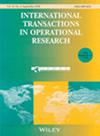考虑到低碳政策,对橡胶轮胎龙门起重机进行油改电改造和部署
IF 3.1
4区 管理学
Q2 MANAGEMENT
引用次数: 0
摘要
为解决港口设备的高碳排放问题,最有效的措施之一是用电力驱动的设备取代柴油驱动的橡胶轮胎龙门起重机(RTG)。然而,对柴油驱动的橡胶轮胎门式起重机进行油改电改造可能会对港口运营效率产生负面影响。此外,在没有低碳政策的情况下,港口企业通常不会主动进行改造。因此,本研究重点关注在碳排放交易(CET)和政府补贴政策下,结合 RTG 的部署对 RTG 进行改造。本文建立了一个整数编程模型,以帮助港口企业确定 RTG 改造和部署的多阶段规划。根据所提模型的对角分块结构,开发了一种采用 Dantzig-Wolfe 分解的列生成方法。然后采用分支-价格法进一步完善模型的最优整数解。数值实验以上海洋山深水港为对象。数值结果表明,实施 CET 和政府补贴政策可减少集装箱码头堆场约 17,630 吨的碳排放量和 8,751,861 美元的运营成本。同时,提高政府补贴和碳交易价格,减少免费碳排放配额,可以鼓励港口企业减少更多排放。本文章由计算机程序翻译,如有差异,请以英文原文为准。
Oil‐to‐electricity retrofitting and deployment of rubber‐tyred gantry cranes considering low‐carbon policies
To address the high‐carbon emissions from port equipment, one of the most effective measures is to replace diesel‐powered rubber‐tyred gantry cranes (RTGs) with electric‐powered alternatives. However, the oil‐to‐electricity retrofitting for diesel‐driven RTGs may negatively impact port operation efficiency. Moreover, port enterprises typically do not initiate the retrofitting without the low‐carbon policies. Therefore, this study focuses on the retrofitting of RTGs in combination with their deployment under the carbon emissions trading (CET) and government subsidy policies. An integer programming model is developed to help port enterprises determine the multistage planning of RTGs' retrofitting and deployment. Based on the block‐diagonal structure of the proposed model, a column generation method employing Dantzig–Wolfe decomposition is developed. The optimal integer solution of the model is then further refined using a branch‐and‐price approach. The Shanghai Yangshan Deep Water Port is used for numerical experiments. Numerical results demonstrate that the implementation of CET and government subsidy policies can reduce approximately 17,630 tons of carbon emissions and $8,751,861 operating costs in container terminal yard. Meanwhile, increasing government subsidies and carbon trading prices, and reducing free carbon emission quotas can encourage port enterprises to reduce more emissions.
求助全文
通过发布文献求助,成功后即可免费获取论文全文。
去求助
来源期刊

International Transactions in Operational Research
OPERATIONS RESEARCH & MANAGEMENT SCIENCE-
CiteScore
7.80
自引率
12.90%
发文量
146
审稿时长
>12 weeks
期刊介绍:
International Transactions in Operational Research (ITOR) aims to advance the understanding and practice of Operational Research (OR) and Management Science internationally. Its scope includes:
International problems, such as those of fisheries management, environmental issues, and global competitiveness
International work done by major OR figures
Studies of worldwide interest from nations with emerging OR communities
National or regional OR work which has the potential for application in other nations
Technical developments of international interest
Specific organizational examples that can be applied in other countries
National and international presentations of transnational interest
Broadly relevant professional issues, such as those of ethics and practice
Applications relevant to global industries, such as operations management, manufacturing, and logistics.
 求助内容:
求助内容: 应助结果提醒方式:
应助结果提醒方式:


